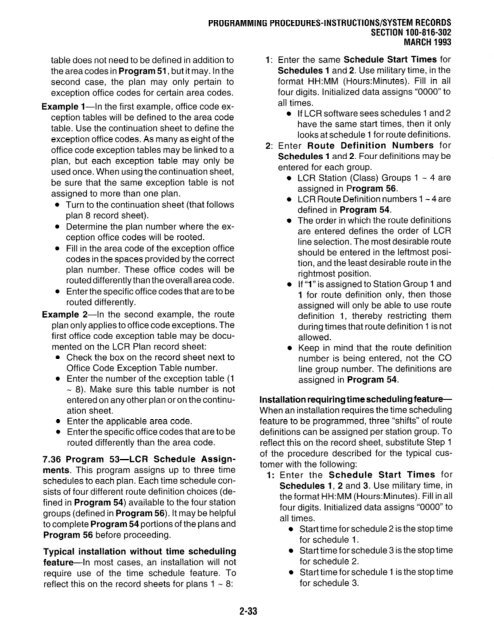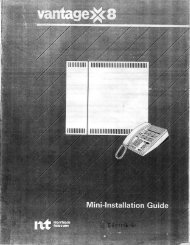Strata DK 16 Manual
Strata DK 16 Manual
Strata DK 16 Manual
You also want an ePaper? Increase the reach of your titles
YUMPU automatically turns print PDFs into web optimized ePapers that Google loves.
table does not need to be defined in addition to<br />
the area codes in Program 51, but it may. In the<br />
second case, the plan may only pertain to<br />
exception office codes for certain area codes.<br />
Example I-In the first example, office code exception<br />
tables will be defined to the area code<br />
table. Use the continuation sheet to define the<br />
exception office codes. As many as eight of the<br />
office code exception tables may be linked to a<br />
plan, but each exception table may only be<br />
used once. When using the continuation sheet,<br />
be sure that the same exception table is not<br />
assigned to more than one plan.<br />
l Turn to the continuation sheet (that follows<br />
plan 8 record sheet).<br />
l Determine the plan number where the exception<br />
office codes will be rooted.<br />
l Fill in the area code of the exception office<br />
codes in the spaces provided by the correct<br />
plan number. These office codes will be<br />
routed differently than the overall area code.<br />
l Enter the specific office codes that are to be<br />
routed differently.<br />
Example 2-In the second example, the route<br />
plan only applies to office code exceptions. The<br />
first office code exception table may be documented<br />
on the LCR Plan record sheet:<br />
Check the box on the record sheet next to<br />
Office Code Exception Table number.<br />
0 Enter the number of the exception table (1<br />
- 8). Make sure this table number is not<br />
entered on any other plan or on the continuation<br />
sheet.<br />
0 Enter the applicable area code.<br />
0 Enter the specific office codes that are to be<br />
routed differently than the area code.<br />
7.36 Program 53-LCR Schedule Assign-<br />
ments. This program assigns up to three time<br />
schedules to each plan. Each time schedule con-<br />
sists of four different route definition choices (de-<br />
fined in Program 54) available to the four station<br />
groups (defined in Program 56). It may be helpful<br />
to complete Program 54 portions of the plans and<br />
Program 56 before proceeding.<br />
Typical installation without time scheduling<br />
feature-In most cases, an installation will not<br />
require use of the time schedule feature. To<br />
reflect this on the record sheets for plans 1 - 8:<br />
2-33<br />
SECTION 100-8<strong>16</strong>-302<br />
MARCH 1993<br />
Enter the same Schedule Start Times for<br />
Schedules 1 and 2. Use military time, in the<br />
format HH:MM (Hours:Minutes). Fill in all<br />
four digits. Initialized data assigns “0000” to<br />
all times.<br />
l If LCR software sees schedules 1 and 2<br />
have the same start times, then it only<br />
looks at schedule 1 for route definitions.<br />
Enter Route Definition Numbers for<br />
Schedules 1 and 2. Four definitions may be<br />
entered for each group.<br />
LCR Station (Class) Groups 1 - 4 are<br />
assigned in Program 56.<br />
LCR Route Definition numbers 1 - 4 are<br />
defined in Program 54.<br />
The order in which the route definitions<br />
are entered defines the order of LCR<br />
line selection. The most desirable route<br />
should be entered in the leftmost posi-<br />
tion, and the least desirable route in the<br />
rightmost position.<br />
If “1” is assigned to Station Group 1 and<br />
1 for route definition only, then those<br />
assigned will only be able to use route<br />
definition 1, thereby restricting them<br />
during times that route definition 1 is not<br />
allowed.<br />
Keep in mind that the route definition<br />
number is being entered, not the CO<br />
line group number. The definitions are<br />
assigned in Program 54.<br />
Installation requiring timeschedulingfeature-<br />
When an installation requires the time scheduling<br />
feature to be programmed, three “shifts” of route<br />
definitions can be assigned per station group. To<br />
reflect this on the record sheet, substitute Step 1<br />
of the procedure described for the typical cus-<br />
tomer with the following:<br />
1: Enter the Schedule Start Times for<br />
Schedules 1, 2 and 3. Use military time, in<br />
the format HH:MM (Hours:Minutes). Fill in all<br />
four digits. Initialized data assigns “0000” to<br />
all times.<br />
l Start time for schedule 2 is the stop time<br />
for schedule 1.<br />
l Start time for schedule 3 is the stop time<br />
for schedule 2.<br />
l Start time for schedule 1 is the stop time<br />
for schedule 3.





